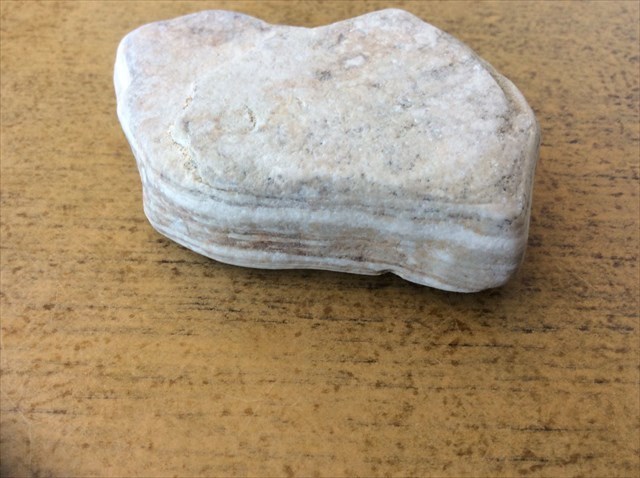Sandstone belongs to the sedimentary rocks and their formation dating back to the Precambrian and Cambrian. Cambrian: From the 542 million years ago to 488 million years ago. Here flowed a sea over the deep eroded Precambrian bedrock surface. The sea was with its changing water depths frame on the sediments and changing environments and exotic life forms that were very different from today's. In early Cambrian sea level rose by at least 200 meters., The early Cambrian sandstone deposited quickly, so the whole process must reflect a substantial increase in global sea level in the few million years, sandstones represent. The loose sand grains originated from cliff erosion. Sand deposits were subsequently cemented together by compression and curing to sandstone in rivers or into the sea. The sandstone is mainly composed of feldspar and quartz and the binding substances for the sand grains are typically calcite, clay and silikater. Sandstone is often layered and with quartz crystals.
Crete is in a very active zone with movements of the african plate down under the eropean plate. The meeting is relative deep in the ground, so the many earthquake is not very destroying. But the sedimentary layers has been turn around.
In the beginning of Miocene epoch 25 million years ago Crete was under water, but a strong tectonic upheaval lifted the bottom of the sea to the surface and a part of Crete became visible. Contemporary the mountains was formed. A new tectonic uplift happened 5-10 million years ago. Before this uplift a kind of sandstone was formed ( mudstones ) and is now visible in some parts of the island.

Limestone consists of three main components: Calciumcarbonate grains, lime slurry (micrit) and carbonate cement. Limestone varies greatly in both texture and color, depending on the scale, grain size and type and impurities.They are usually light, but even a low content of iron compounds or organic matter can color them red, green, blue or almost black.
Limestone can be either biogenic (organic) or chemically precipitated and found in marine environments and in freshwater environments. Most limestone is deposited on shallow water (under 15 m) in subtropical or tropical climate, where temperature, light conditions and nutritional supply are most favorable for lime-producing organisms, but they can also be formed in cold water in temperate climates. Often they are formed by growth on the spot, such as in shell banks and reefs (coralalk and bryozokalk) or know that carbonate sediment is captured and bound by algae (stromatolites). Lime can also be deposited on deep water, ie. 4000-5000 m.
Biogenic limestone usually contains shell fragments of lime-producing organisms. The organisms that mainly contribute with material are corals, bryozos, snails, mussels, sea urchins, silver lilies, brachiopodes, coccolites (algae) and foraminifers. The composition reflects environmental conditions during sedimentation, water depth, temperature and salinity. Limestone is known back to 2.7 billion years ago, but a lot were created in the period from 100 to 65 million years ago. Limestone and chalk have also been formed where the conditions have been favorable. In Crete there has probably been lime formation up to 5 - 10 million years ago. Therefore, the mountain species on the Crete are dominated by limestone.



Different organisms forming chalk
Fossils is the impressions of animals or plants in stone - or rarely in amber that is older than 10,000 years and can thus be incorporated into the geological age before the beginning of it geological era holocene. Such historical geological documents can be both physical remains of living creatures (body fossils) or traces of their activities (sporfossils). For example, stony footprints and excrements (Koprolit) are also calculated as fossils. The formation of fossils is called fossilization. Fossil research is predominantly under Palaeontology.
According to scientifically based estimates, approximately one billion animal and plant species originated since the beginning of Phanerozoikum 541 million years ago and extinctly died again. Just under one percent of this artichoke is preserved as fossils not only because of the special circumstances necessary for the fossilization, but also because many fossils are destroyed over millions of years due to weathering, erosion, or when subjected to high pressure and temperature. Up to 1999, approximately 250,000 fossil species are scientifically described.
Fossils of microscopic filaments and tubes formed of bacteria have been found in Canada. They are dated to between 3.77 and 4.3 billion years, and these fossils are thus the oldest traces of life on earth.

Example of prehistoric octopus, which became extinct 65 million years ago.
To log this cache you must answer the questions and send the answers to our profile. Then you may log.
Questions:
1 Estimate the length and width of the coast's rock area?
2. A) Examine the stones around GZ and 10-20 meters on both sides: Is there sandstone, limestone or both? B) What is the difference between the formation of limestone and sandstone? C) Can both types of stones contain fossils and why?
3. Find 5 Stones with fossils, describe them.
4. Close your eyes and pick up 10 random stones. Then see how many of them contain fossils.